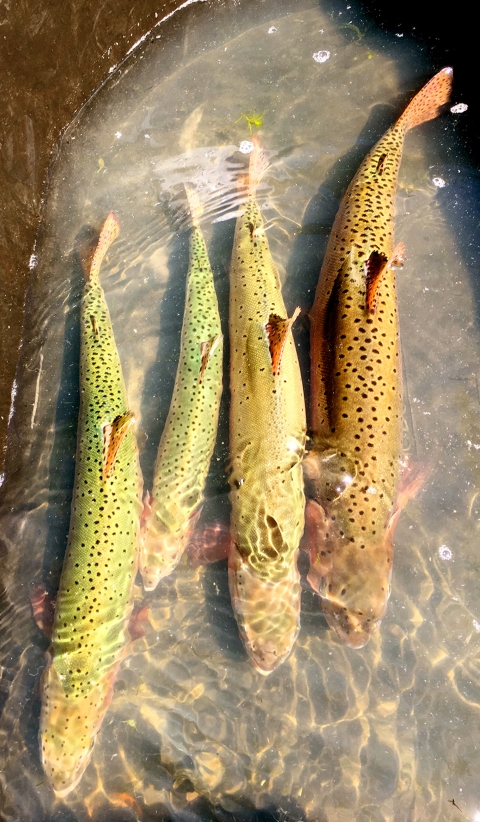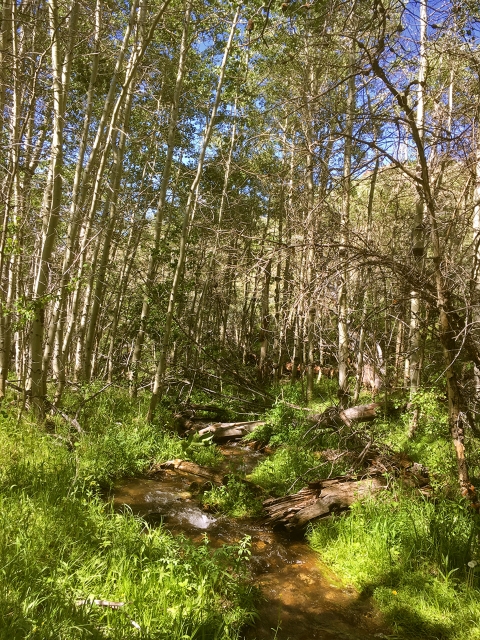Lahontan cutthroat trout, the largest cutthroat trout subspecies in the world, travel nearly 17 miles each year to spawn in the tributary creeks feeding northwestern Nevada’s Summit Lake. The federally protected fish will now be able to make their journey much easier this spring.
The Service’s National Fish Passage Program and Partners for Fish and Wildlife Program teamed up with the Summit Lake Paiute Tribe to replace a 40-year-old culvert that had been hindering spawning runs on Mahogany Creek for the threatened trout species during multiple past drought years.
Mahogany Creek is one of only two tributaries, along with Snow Creek, that supplies water to Summit Lake within the Paiute reservation’s boundary, and the only stream used by the Lahontan cutthroat for reproduction.
“Not only is it a critical passage for our traditional trout species, but the culvert that was replaced also serves as the only structure for vehicular traffic on the reservation to pass across Mahogany Creek,” said William Cowan, the Summit Lake Paiute Tribe’s natural resources department director.
The former decaying culvert was an elliptical, corrugated pipe design that restricted fish passage fish passage
Fish passage is the ability of fish or other aquatic species to move freely throughout their life to find food, reproduce, and complete their natural migration cycles. Millions of barriers to fish passage across the country are fragmenting habitat and leading to species declines. The U.S. Fish and Wildlife Service's National Fish Passage Program is working to reconnect watersheds to benefit both wildlife and people.
Learn more about fish passage during low water flow years. The stream bed under the old culvert had also eroded, causing stream flows to leak under the pipe. As a result, a “plunge pool” eventually developed at the downstream edge of the culvert, which further decreased water depth in the pipe and required fish to jump and burst as they swam in order for them to ascend through the barrier into upstream waters.
A new bottomless arch design culvert was installed that more closely mimics the natural stream channel and does not alter the stream bed or gradient, allowing spawners and juvenile trout to pass more safely in any stream flow conditions. Now fish can migrate through the arch culvert without having to reduce their speed and tire themselves unnecessarily, minimizing injury and reducing impacts to their migratory behavior.
The new culvert design involved hydrologic analysis to estimate water flows and the frequencies of floods. It also had to take into account sufficient load ratings for vehicles and other heavy equipment to cross the stream.
Rip-rap (boulders and cobblestones) was strategically placed on the upstream and downstream edges and sides of the arch culvert to firmly anchor the structure in the event of flooding.
Cobble-sized rocks were placed under the arch culvert to simulate stream channel substrate roughness and to provide resting areas for migratory fish. The man-made rock bottom also serves as habitat for other aquatic invertebrate species including insects, snails, worms and crayfish that provide a food source for trout along their spawning path.
“Otis Bay Ecological Consultants, the contractor on the project, was also especially mindful to preserve habitat and substrate for our endemic freshwater mussels and to minimize any disturbance to the creek’s riparian riparian
Definition of riparian habitat or riparian areas.
Learn more about riparian vegetation,” said Cowan.
“This fish passage project was extremely important for Lahontan cutthroat trout to promote unimpeded spawning migrations in the stream and to aid the recruitment of juvenile fish to Summit Lake during low flow conditions,” said Tim Loux, the Service’s Region 8 national fish passage program coordinator. “The project was especially important for the Summit Lake Paiute Tribe because the new culvert will enhance and protect their fisheries, a culturally significant resource.
"Additionally, vehicles and heavy equipment can now safely cross the creek to help improve and maintain tribal facilities and resources south of Mahogany Creek,” he said.
The protection, enhancement and management of threatened Lahontan cutthroat trout is a primary conservation goal shared by the Service and tribe to eliminate threats and help ensure the long term persistence of the species.
“The Summit Lake watershed supports the largest, self-sustaining, lake-dwelling population of Lahontan cutthroat trout within its native range,” said Cowan. “We are extremely proud to further the mission to protect this species because our tribal culture is inherently tied to the diversity of wildlife and natural resources surrounding this lake.”
Traditionally, members of the Summit Lake Paiute Tribe are known as Agai Panina Ticutta, meaning "lake trout eaters.” Although the traditional homelands of the Summit Lake Paiute Tribe spans 2,800 square miles, Summit Lake was the focal point of occupation for the Tribe.
According to Cowan, the Tribe is dedicated to preserving ecological function, natural resources and biodiversity of species within the Summit Lake watershed, including Lahontan cutthroat trout, to continue traditional and cultural ways of life.







